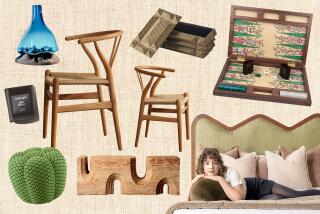Shaker: Plain but Fancy-Priced : An unforeseen advantage in the austere style is that it works in many environments.
- Share via
Shaker furniture is hot, even a little sexy, these days. It wasn’t always that way for these utilitarian pieces steeped in religious tradition.
Much like American folk art, which has become respected and much sought after, Shaker furniture was once dismissed as too primitive to be of real interest. Or of real value. But what was once primitive is now elegant. As for value, some Shaker work has fetched as much as $250,000 at auction.
Obviously, there are fans.
One is Bud Fitzgerald, an amateur woodworker from Fountain Valley. Fitzgerald can’t afford to buy genuine Shaker furniture, but he looks for pieces that reflect Shakers’ simple designs.
“You have to like the appearance if you like things that are basic and unpretentious,” Fitzgerald said. “I tend to buy stuff that [embraces] that [Shaker] ideal. . . . I also keep that in mind when I make my own furniture in the garage.”
Another fan is Christian Becksvoort, a craftsman and author who has studied the Shakers and their furniture for years. His new book, “The Shaker Legacy” ($40, Taunton Books), puts the Shakers and their homespun artifacts in perspective.
Like Fitzgerald, Becksvoort traces the furniture’s popularity to its unassuming style, which always placed practicality over fussy ornamentation.
“The Shakers were way ahead of their time in making furniture functional first and having whatever beauty or form or charm take a back seat to the function of the piece,” Becksvoort explained.
“I think that rings true with a lot of people today. Because it’s so plain, it tends to fit well into almost any kind of an environment, any kind of decor.”
Then there’s the interest in the Shakers themselves. The author believes you can’t separate the Shakers’ history and religious beliefs from the pieces they created.
Becksvoort has studied the Shakers since the 1970s, when he began restoring the furniture of one of the last thriving Shaker communities, in Sabbathday Lake, Maine.
He came to realize that “the Shakers strive to glorify God through all their labor, whether they are peeling a potato, mending a dress, sweeping a floor or turning a chair leg [on a lathe]. Furniture is merely a byproduct of their entire religious experience.”
That experience, Becksvoort notes, began in the mid-18th century in England as an offshoot of the Quakers. Founded by James and Jane Wardley, Shakers were called the Wardley Society and known for “a mystical, ecstatic form of worship in which they trembled, shook, sang, danced and fell into trances.” It wasn’t long before followers of the Wardley Society were referred to as “Shaking Quakers.”
The sect found a strong leader when Ann Lee joined in 1758. She took on the name Mother Ann, preached celibacy, was arrested several times for her zealotry and was instrumental in leading the Shakers to America in 1774 to escape what she believed to be persecution in England. After landing in New York City, they settled just north of Albany and started looking for converts, whom they found throughout the northeast states, Ohio and Kentucky.
Like the Amish, they tried to separate themselves from society at large. But unlike the Amish, which Becksvoort said they are often confused with, the Shakers embraced new technology over the years, from cars to power tools.
“Although they believed that all human beings were prone to sin, they also believed that people were perfectible,” Becksvoort said. “They believed in progress [and ways] to improve their environment.”
Using modern techniques may have improved the construction of the furniture in later years, but the designs have remained pretty much the same since the Shakers came to New York: symmetrical, often sharp-angled lines reflecting basic geometric forms such as squares, rectangles and circles. To be more complicated or pretty would be not only irreverent but also impractical.
“Furniture was not an end in itself--it was a tool,” Becksvoort said. “It was a means to getting the job done, to making life more efficient.”
And to this day, the few Shaker communities left are still bemused that their furniture has become so prized by collectors.
“To them, it’s merely a piece of wood, whether it’s a sewing desk or a dining table,” he said. “I recall [a] little sewing desk that was sold at auction for close to $250,000. They’re still using [ones similar to that] on a day-to-day basis. They stick pins in them [and] drop scissors on them, and they just don’t comprehend what all the fuss is about.”
That comment made Joseph Lathrop smile. Like Becksvoort and Fitzgerald, he admires Shaker furniture and the inspiration behind it.
“You have to love their unfrivolous approach to things,” said Lathrop, a wood crafter from Seal Beach. “The best stuff often comes when you keep it simple, when you take on a less-is-more attitude. . . . The Shakers and their work are such good examples of that.”






